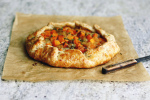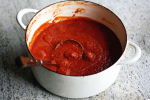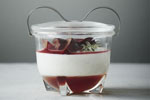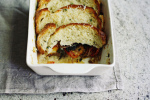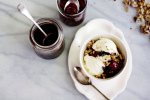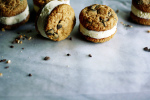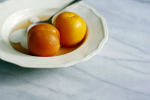The essence of home
 Wednesday, June 29, 2005 at 10:59AM
Wednesday, June 29, 2005 at 10:59AM I’ve been putting off writing this post. The topic seemed simple enough, but whenever I tried to come up with an answer to the question, I was overwhelmed.
“What does Canada taste like to you?”
Deciding on one taste that most embodies the Canadian experience is, in my opinion, nearly impossible. With a country of such physical size and cultural contrasts, to concentrate on one flavour would be to exclude the thousands of other culinary adventures there are to be had.
To me, Canada tastes like maple syrup on my father’s French toast. I think of a butter-drenched crab boil on one coast, and Asian-influenced seafood on the other. Summer evenings wandering the streets of Montréal, shopping for decadent Opéra cakes. The requisite hotdog from Toronto street vendors. Breakfast cooked over a campfire, with smoky bacon and biscuits baked in a cast iron pan.
Canada tastes as sweet as summer fruit, as hearty as pierogies and as complex as our world-renowned wines. Canadian food reflects our varied climates, our landscapes and our seasons – it is the expression of the way we have created communities in this immigrant nation, and suggests the direction of what is to come.
Despite my travels, I would wager to say 85% of all the meals I’ve ever eaten have been in Canada. Seeing that I’m now somewhat obsessed with food, my food adventures this country surely have been nothing short of inspiring. Though I am itching to continue to travel the world and try new things, Canada will always be home to me. There is enough to explore down the street, throughout the province and across the nation to sustain me for years to come.
Maybe it would be easier if I concentrated on what Canada Day tastes like to me?
That’s easy. Growing up in a city on the edge of Lake Ontario, Canada Day meant one thing, and one thing alone – the annual Lion’s Club carnival. Every long weekend for the summer, the Lion’s Club carnival would make its rounds through local fairs and festivals throughout our region. And Canada Day was when it would come to my city.
Along with the other kids in our neighbourhood, I would watch the workers set up the tilt-a-whirl, Ferris wheel, and midway down by the beach. Soon enough, you could smell the popcorn and the air would become heavy with the sweetness of cotton candy. Twinkling lights would greet nightfall, and we would wait for the inky blackness to blanket the lake completely – setting the stage for the evening’s fireworks display.
Inspired by those memories, I’ve created miniature sweet wonton cones filled with icewine-macerated strawberries. The strawberries come from a nearby farm, the wine from a winery down the highway, and the wontons are my nod to Canada’s distinct cultural heritage. It is seasonal, the ingredients are local, and there is a bit of kitschy humour – how very Canadian. And red and white on Canada Day - how can you go wrong?
For an explanation of icewine and its production, click here.
Icewine strawberries in sweet wonton cones
My own creation, with apologies to Thomas Keller
Ingredients
1 pint strawberries
1/4 cup icewine
1 cup clarified butter
16 x 3 1/2” square wonton wrappers (4 are in case of mishap – and anyway, that is what my package contained)
2 tablespoons granulated sugar or Demerara sugar
Sweetened whipped cream, to serve
Speciality utensils
12 conical shaped metal forms (the type used for kulfi will do) or conical paper cups for water dispensers
Preheat oven to 350°F (175°C).
Hull and slice the strawberries, taking into account the size of your cone forms. Add the berries to a bowl and add the icewine. Stir lightly to combine, and refrigerate for at least two hours.
On a baking sheet, set out the metal forms or the paper cups. Brush each wonton on both sides with clarified butter. Wrap wonton wrappers around the cups to form cones, making sure to press the seams together. Twist the bottom to secure the point, if necessary. Lightly dust the cones with the granulated sugar, and bake for 7 minutes or until golden brown and crispy. Allow to cones to cool and remove from forms.
To serve, mound some of the macerated strawberries into your sugared cones, and top with the whipped cream.
Notes
• I used an Inniskillin 2002 Riesling Icewine for this recipe, thinking the floral apricot notes and bright acidity would complement the strawberries. Any icewine you enjoy would be suitable, or even a late harvest Vidal would be a great substitution, offering a bit of spice and sweet peach flavours.
• For Ontario readers, the LCBO does offer icewine in small bottles (a bit larger than hotel room minis). This size would be perfect to splash on a few berries, and are reasonably priced.
• I chose not to add sugar to the berries, but you may want to check for sweetness and add sugar accordingly.
• For the photograph, I used a non-sugared cone. It was terribly humid that day, and sugar was melting into a sticky mess. However, I would not suggest skipping this step as the wonton seems too savoury without this bit of gilding.
• The next time I make these cones, if I'm feeling particularly industrious that is, I think I would experiment with a tuile cone instead - if anyone experiments, please let me know!


